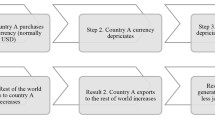Abstract
Although China, now the world’s second largest economy and largest goods trading nation, has rolled out the ambitious currency internationalization protocol while maintaining strict capital controls for nearly a decade, the implications of this unique reform path on the international economy still present uncertainties. In this paper, we fill in this gap by developing a two country, two-goods model to investigate the impacts of currency internationalization on the international price system, which consists of goods market and factor market interactions. We propose a critical condition of sustainable currency internationalization and reveal high international price sensitivity to exchange rate adjustments.

Similar content being viewed by others
Notes
In reality, this can also be reflected by the reduction of the liquidity premium of the RMB in the offshore
market over the RMB in the onshore market (Cheung and Rime 2014).
When there exists home bias in consumption functions, the real exchange rate will face similar lower and upper bounds, though of different values. For example, if the two goods are substitutes (ϕ > 1) and the two countries share the same home bias, then the constraint of the real exchange rate can be written as: \( \left(1-\theta \right){\left(\frac{a}{1-a}\right)}^{1/\left(1-\phi \right)}<\varepsilon <{\left(\frac{a}{1-a}\right)}^{1/\left(1-\phi \right)} \), where a > 0.5 represents the home bias.
For C-D consumption function (ϕ = 1), the limit does not exist: \( \underset{\phi \to {1}^{-}}{\lim }=\infty \) while \( \underset{\phi \to {1}^{+}}{\lim }=0 \).
In simulation, the literature usually sets gross elasticity of substitution slightly above unity (e.g., Backus et al. 1994; Heathcote and Perri 2002; Engel and Matsumoto 2009). Nonetheless, Feenstra et al. (2012) estimate that the gross elasticity is not significantly different from one. Thus, we use four values of ϕ in the simulation: 0.7, 0.9, 1.1, and 1.3.
References
Backus, K., Kohoe, P., & Kydland, F. (1994). Dynamics of the trade balance and the terms of trade: The J-curve? American Economic Review, 84, 84–103.
Batten, J. A., & Szilagyi, P. G. (2016). The internationalisation of the RMB: New starts, jumps and tipping points. Emerging Markets Review, 28, 221–238.
Cheung, Y. W., & Rime, D. (2014). The offshore Renminbi exchange rate: Microstructure and links to the onshore market. Journal of International Money and Finance, 49, 170–189.
Dorrucci, E. and Mckay, J. (2011), The international monetary system after the financial crisis. European Central Bank Occasional Paper Series No. 123.
Eichengreen, B. (2011). Exorbitant privilege: The rise and fall of the dollar and the future of the international monetary system. New York: Oxford University Press.
Eichengreen, B., & Kawai, M. (2014). Issues for renminbi internationalization: An overview. ADBI Working Paper No., 454 Available at: https://www.adb.org/sites/default/files/publication/156309/adbi-wp454.pdf.
Engel, C., & Matsumoto, A. (2009). The international diversification puzzle when prices are sticky: It’s really about exchange-rate hedging not equity portfolios. American Economic Journal: Macroeconomics, 1, 155–188.
Feenstra, R., M. Obstfeld and Russ, K. (2014). In Search of the Armington Elasticity. NBER Working Paper. Available at: http://www.nber.org/papers/w20063.pdf.
Heathcote, J., & Perri, F. (2002). Financial autarky and international business cycles. Journal of Monetary Economics, 49, 601–627.
Jin, H. and Wang, T. (2017). Dynamic Currency Intervention and International Monetary Neutrality. Theoretical Economic Letters, 7, 575–581.
Jin, H., Lombardi, D. and Hu, C. (2015). Chapter 6: Macroeconomic constraints under currency intervention. In Enter the Dragon: China in the international Financial System, eds. by D. Lombardi and H. Wang. CIGI press. ISBN: 978-1-928096-15-3.
Kroeber, A. (2013). A Chinese Trilemma: Renminbi Internationalization, Capital Account Opening, and Domestic Financial Liberalization. Harvard Law School PIFS China-U.S. Symposium.
Lietaer, B. and Belgin, S. (2012). New Money for a New World, Qiterra Press, Boulder, CO, USA.
Roger, S. (2010). Inflation Targeting Turns 20. Finance & Development, 47, 46–49.
Zhou, X. (2009). Reform the International Monetary System. Speech delivered 23 March, available at http://www.bis.org/review/r090402c.pdf (Retrieved 26 Jan 2014).
Author information
Authors and Affiliations
Corresponding author
Rights and permissions
About this article
Cite this article
Jin, H., Takumah, W. & Jorenby, J. Currency Internationalization and the International Price System. Int Adv Econ Res 24, 303–309 (2018). https://doi.org/10.1007/s11294-018-9711-y
Published:
Issue Date:
DOI: https://doi.org/10.1007/s11294-018-9711-y




